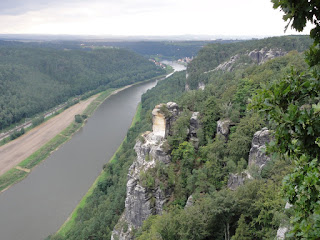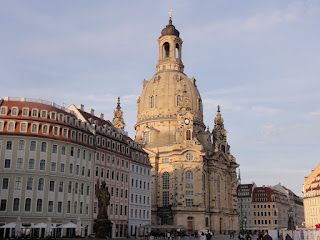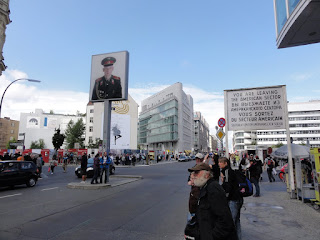Four hours later, we were up. We got dressed, finished packing and went to Marika’s apartment for a quick breakfast. Then she drove us to Schoenefeld Airport. We checked in, then sat with her for a while before saying our goodbyes and going through security.
Our 9:20 a.m. flight to Luton was uneventful. We took the shuttle bus to the train station, where we had spent hours in 2003, due to a signal malfunction that had shut down the rail line. We caught the train to London St. Pancras Station, which had been refurbished and upgraded in 2007, in order to serve as the terminus for the Eurostar trains to France. There I bought Underground tickets, but was unable to use them then, since the line we would have used was shut for repairs. We probably could have walked, but instead flagged down one of the famous London black taxis. The relatively short ride to our hotel cost less than the tube tickets.
The side streets in the Bloomsbury neighborhood of London are full of 18th-century townhouses, many of which have been turned into small hotels. The Arosfa Hotel, at 83 Gower Street, is one such hotel. In this building, where the painter John Everett Millais lived with his parents at the middle of the 19th century, the Pre-Raphaelite Society was supposedly founded. We’d seen several Millais paintings (including Ophelia) at the Tate Britain, as well as his statue, at the rear of that gallery.
Arosfa Hotel, at 83 Gower Street, is one such hotel. In this building, where the painter John Everett Millais lived with his parents at the middle of the 19th century, the Pre-Raphaelite Society was supposedly founded. We’d seen several Millais paintings (including Ophelia) at the Tate Britain, as well as his statue, at the rear of that gallery.
We were greeted by Nicholas, a 40-ish man with what sounded like a Russian accent. Our room (number six) was ready, so he showed us up and gave us the key. The room, as well as the hotel as a whole, was pleasant and comfortable. The windows, overlooking Gower Street, were well soundproofed, but since there was no air-conditioning and it was becoming warm, the windows had to be ope n. However, there was an electric fan in the room. Not only did that cool things down, but its white-noise roar drowned out the traffic noises from the street. This was a very small room. It may have been the smallest double hotel room with ensuite bathroom that I’d ever seen, much less stayed in! It was, at most, eight feet across, and maybe fourteen feet long, including the bathroom.
n. However, there was an electric fan in the room. Not only did that cool things down, but its white-noise roar drowned out the traffic noises from the street. This was a very small room. It may have been the smallest double hotel room with ensuite bathroom that I’d ever seen, much less stayed in! It was, at most, eight feet across, and maybe fourteen feet long, including the bathroom.
As soon as we’d settled in, we went out lookjng for lunch. We found it at an Italian restaurant on Tottenham Court Road. Mary Joy was very pleased with the food,and made that abundantly clear to the staff. Once again, her enthusiasm charmed a restaurant’s staff so much that they gave us something extra--little after-dinner glasses of limoncello. As we left, the waiter and waitress even gave her the European greeting of a triple air-kiss, while I was out front putting up my umbrella!
Rather than contend with the heaviest rain of the entire trip, we went back to our room, and I blogged , my chair backed up to the bed, while Mary Joy napped.
We left around a quarter after four to head for Westminster Abbey, and immediately ran into problems. I couldn’t find the Goodge Street underground station, probably because it was closed. We walked down to the Tottenham Court Road station, at Oxford Street, and discovered that the entire Metropolitan Line was shut down for a year or so, so we had to rearrange our route, and when we came out into the sunlight at Westminster, beneath the gleaming tower of the Houses of Parliament, it was already after five. We missed the first fifteen minutes, but evensong was still very nice. Mary Joy says that no one does this sort of liturgical music better than the Anglicans (whenever she hears the choir of St. Peter’s in Rome on TV, she cringes).
discovered that the entire Metropolitan Line was shut down for a year or so, so we had to rearrange our route, and when we came out into the sunlight at Westminster, beneath the gleaming tower of the Houses of Parliament, it was already after five. We missed the first fifteen minutes, but evensong was still very nice. Mary Joy says that no one does this sort of liturgical music better than the Anglicans (whenever she hears the choir of St. Peter’s in Rome on TV, she cringes). 
We walked down Victoria Street to Westminster Cathedral, as we had two weeks before, for six o’clock mass. Mary Joy wasn’t feeling well, so we went straight back to our hotel and went to bed early.
The next day (Sunday, August 21st), we had a hearty breakfast with scrambled eggs and English bacon at our B and B, and wandered around a little in Bloomsbury, picking up our tube tickets in a crowd at the Russell Square station. We then checked out around 11:15, went back to the Russell Square station and discovered that I had not two tickets, but one ticket and a receipt! However, since there was now no crowd, I could quickly buy another five-pound ticket. We took the “lift” down to the Piccadilly Line platform, and I realized that I wasn’t sure which terminal we were flying out of at Heathrow. I would have guessed that it was Terminal 4, but I wasn’t sure, and the first train that left was going to 1, 2, 3 and 5, rather than 4, 1, 2 and 3. We asked a British couple on the train, and they thought that Terminal 4 was only for cargo. But there were signs on the train saying that fifty airlines were having their terminals changed at Heathrow, and sure enough, when we got off at Terminal 3, we discovered that Delta was at Terminal 4. But tube employees got us back down to the platform, where we caught a train back to Hatton Cross (the last previous station), then another to Terminal 4. From there on, no problems, and we were back home around 6 p.m.
Our 9:20 a.m. flight to Luton was uneventful. We took the shuttle bus to the train station, where we had spent hours in 2003, due to a signal malfunction that had shut down the rail line. We caught the train to London St. Pancras Station, which had been refurbished and upgraded in 2007, in order to serve as the terminus for the Eurostar trains to France. There I bought Underground tickets, but was unable to use them then, since the line we would have used was shut for repairs. We probably could have walked, but instead flagged down one of the famous London black taxis. The relatively short ride to our hotel cost less than the tube tickets.
The side streets in the Bloomsbury neighborhood of London are full of 18th-century townhouses, many of which have been turned into small hotels. The
 Arosfa Hotel, at 83 Gower Street, is one such hotel. In this building, where the painter John Everett Millais lived with his parents at the middle of the 19th century, the Pre-Raphaelite Society was supposedly founded. We’d seen several Millais paintings (including Ophelia) at the Tate Britain, as well as his statue, at the rear of that gallery.
Arosfa Hotel, at 83 Gower Street, is one such hotel. In this building, where the painter John Everett Millais lived with his parents at the middle of the 19th century, the Pre-Raphaelite Society was supposedly founded. We’d seen several Millais paintings (including Ophelia) at the Tate Britain, as well as his statue, at the rear of that gallery.
We were greeted by Nicholas, a 40-ish man with what sounded like a Russian accent. Our room (number six) was ready, so he showed us up and gave us the key. The room, as well as the hotel as a whole, was pleasant and comfortable. The windows, overlooking Gower Street, were well soundproofed, but since there was no air-conditioning and it was becoming warm, the windows had to be ope
 n. However, there was an electric fan in the room. Not only did that cool things down, but its white-noise roar drowned out the traffic noises from the street. This was a very small room. It may have been the smallest double hotel room with ensuite bathroom that I’d ever seen, much less stayed in! It was, at most, eight feet across, and maybe fourteen feet long, including the bathroom.
n. However, there was an electric fan in the room. Not only did that cool things down, but its white-noise roar drowned out the traffic noises from the street. This was a very small room. It may have been the smallest double hotel room with ensuite bathroom that I’d ever seen, much less stayed in! It was, at most, eight feet across, and maybe fourteen feet long, including the bathroom.
As soon as we’d settled in, we went out lookjng for lunch. We found it at an Italian restaurant on Tottenham Court Road. Mary Joy was very pleased with the food,and made that abundantly clear to the staff. Once again, her enthusiasm charmed a restaurant’s staff so much that they gave us something extra--little after-dinner glasses of limoncello. As we left, the waiter and waitress even gave her the European greeting of a triple air-kiss, while I was out front putting up my umbrella!
Rather than contend with the heaviest rain of the entire trip, we went back to our room, and I blogged , my chair backed up to the bed, while Mary Joy napped.
We left around a quarter after four to head for Westminster Abbey, and immediately ran into problems. I couldn’t find the Goodge Street underground station, probably because it was closed. We walked down to the Tottenham Court Road station, at Oxford Street, and
 discovered that the entire Metropolitan Line was shut down for a year or so, so we had to rearrange our route, and when we came out into the sunlight at Westminster, beneath the gleaming tower of the Houses of Parliament, it was already after five. We missed the first fifteen minutes, but evensong was still very nice. Mary Joy says that no one does this sort of liturgical music better than the Anglicans (whenever she hears the choir of St. Peter’s in Rome on TV, she cringes).
discovered that the entire Metropolitan Line was shut down for a year or so, so we had to rearrange our route, and when we came out into the sunlight at Westminster, beneath the gleaming tower of the Houses of Parliament, it was already after five. We missed the first fifteen minutes, but evensong was still very nice. Mary Joy says that no one does this sort of liturgical music better than the Anglicans (whenever she hears the choir of St. Peter’s in Rome on TV, she cringes). 
We walked down Victoria Street to Westminster Cathedral, as we had two weeks before, for six o’clock mass. Mary Joy wasn’t feeling well, so we went straight back to our hotel and went to bed early.
The next day (Sunday, August 21st), we had a hearty breakfast with scrambled eggs and English bacon at our B and B, and wandered around a little in Bloomsbury, picking up our tube tickets in a crowd at the Russell Square station. We then checked out around 11:15, went back to the Russell Square station and discovered that I had not two tickets, but one ticket and a receipt! However, since there was now no crowd, I could quickly buy another five-pound ticket. We took the “lift” down to the Piccadilly Line platform, and I realized that I wasn’t sure which terminal we were flying out of at Heathrow. I would have guessed that it was Terminal 4, but I wasn’t sure, and the first train that left was going to 1, 2, 3 and 5, rather than 4, 1, 2 and 3. We asked a British couple on the train, and they thought that Terminal 4 was only for cargo. But there were signs on the train saying that fifty airlines were having their terminals changed at Heathrow, and sure enough, when we got off at Terminal 3, we discovered that Delta was at Terminal 4. But tube employees got us back down to the platform, where we caught a train back to Hatton Cross (the last previous station), then another to Terminal 4. From there on, no problems, and we were back home around 6 p.m.











































